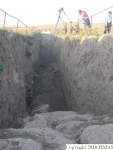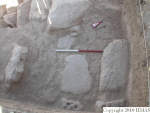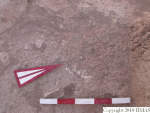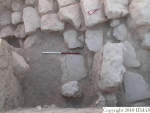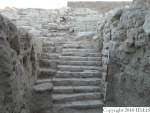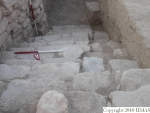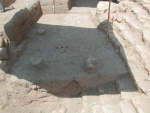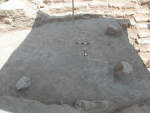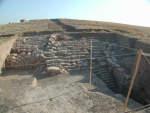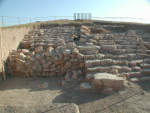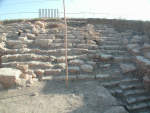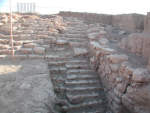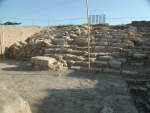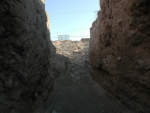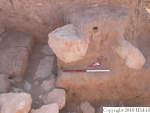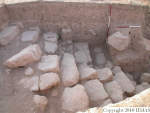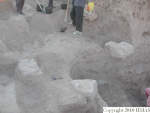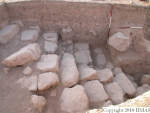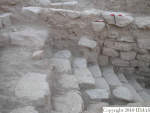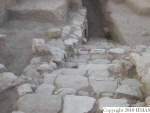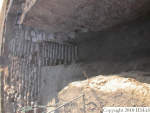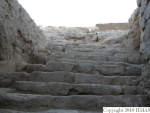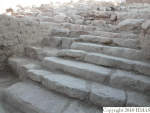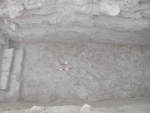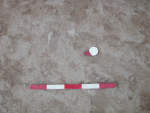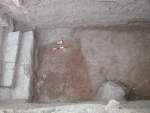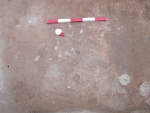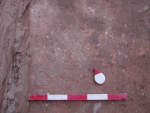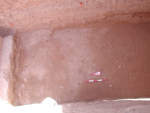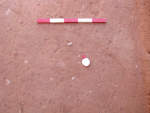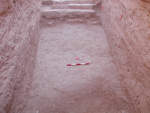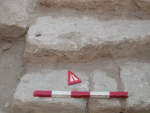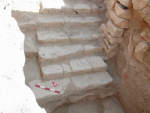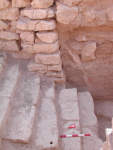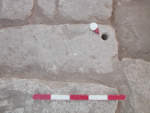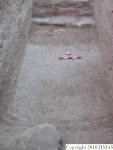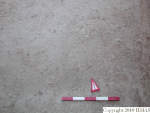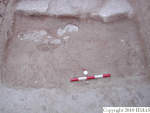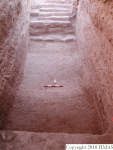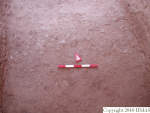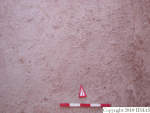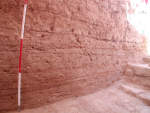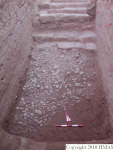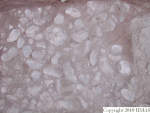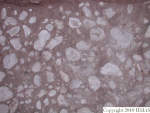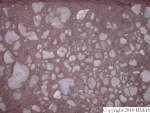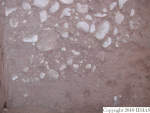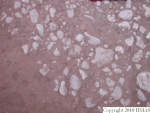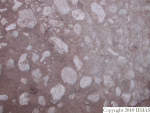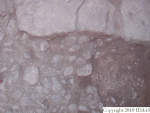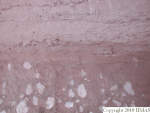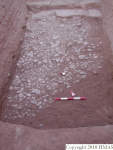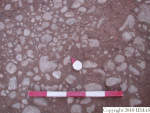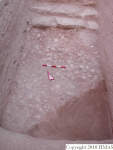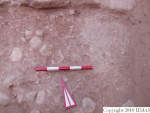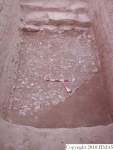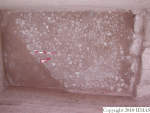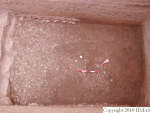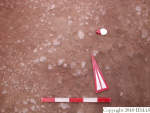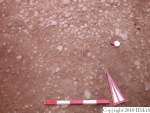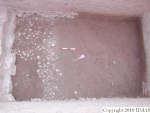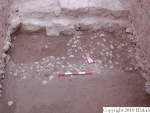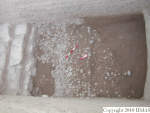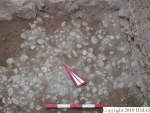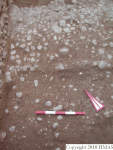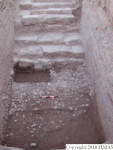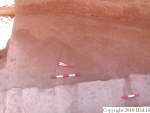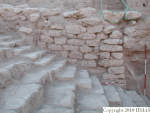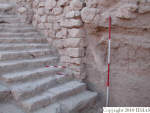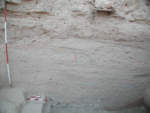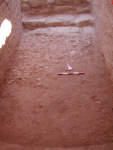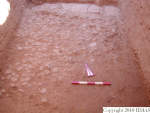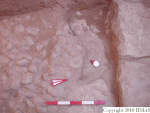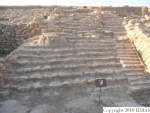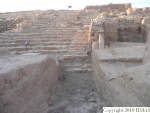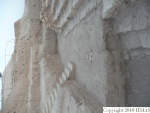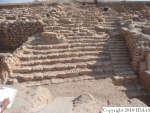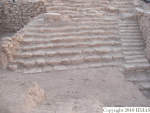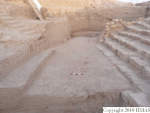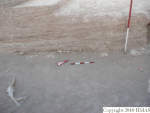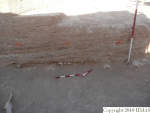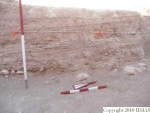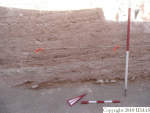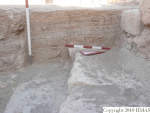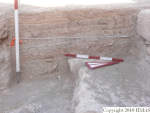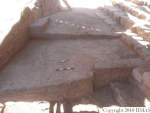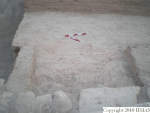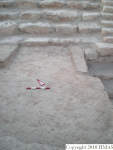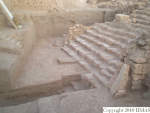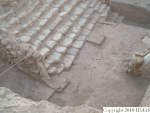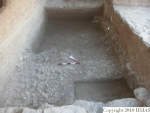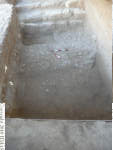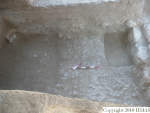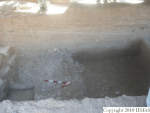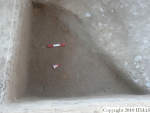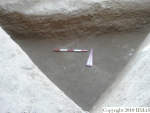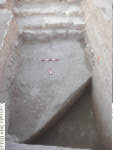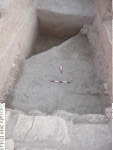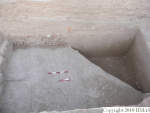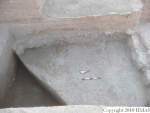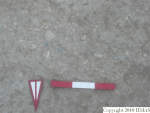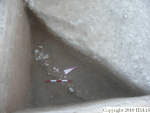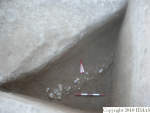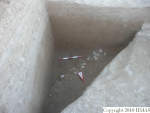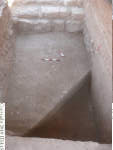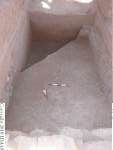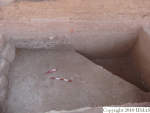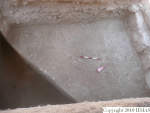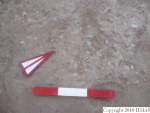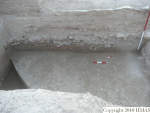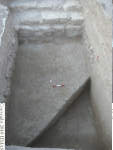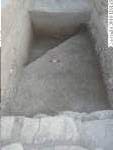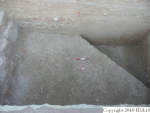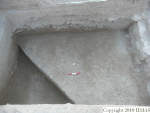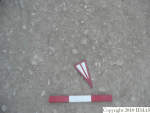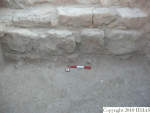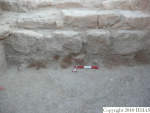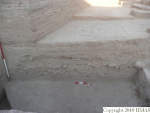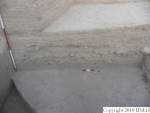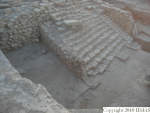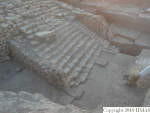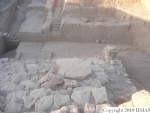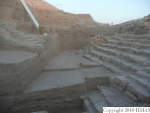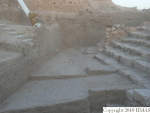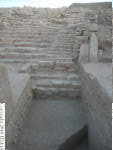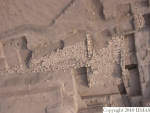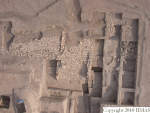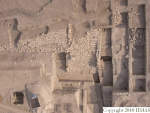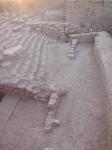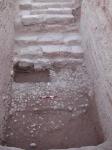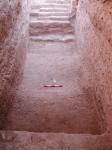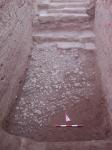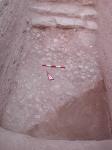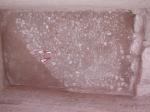1. OVERVIEW
| Roster | Date | Author | Record |
|---|---|---|---|
| Best image | 2014-10-24 | cJC |  [Input: YX24CJC.j] [Input: YX24CJC.j] |
2. IDENTIFICATION
Designation
| Roster | Date | Author | Record |
|---|---|---|---|
| Description (summary) | 2004-06-27 | mH | 15m stretch of south of m3583 in the long German trench [Input: O627MH2.j] |
| 2008-03-07 | pC | k100 from the beginning of the excavation in J2 was associated to the long german trench above the staircase f130. This trench was circa 1,5 m wide and several meters long, beginning from area C2 south of the temple terrace, until the temple BA. here k100 is only the lower part of the staircase [Input: S206PC.j] | |
| 2009-08-15 | cJC | This year k100 is defined in the east by J6k106 and k110 in the west. In the north this locus is bounded by the lower staircase f380. The south section is defined by markers along the site-wide grid. [Input: T815CJC.j] | |
| 2009-09-02 | cJC | This season k100 is defined by r1129 (SW), r1130 (SE), r673 (NW), and r670 (NE). [Input: T830CJC.j] |
3. STRATIGRAPHY
Recovery/Assignment
| Roster | Date | Author | Record |
|---|---|---|---|
| Daily notes about recovery of elements | 2004-06-29 | mH | Towards the end of the day we got the elevator working. We started removing the weather induced collapse roughly in the middle of the unit. [Input: O629MH3.j] |
| 2004-06-30 | mH | In the morning we tried to use the elevator and continue to clear soil from roughly in the middle of the unit. The machine, however, worked roughly two minutes at a time. While it would always restart again, we were not able to make a lot of progress. After a while we abandoned the elevator only to return to it after breakfast. By that time the switch protecting the motor had been removed and we tried to use it again. After a short amount of time the machine got stuck and we were not able to use it. [Input: O630MH.j] | |
| 2004-07-05 | mh | The machine worked fine all day. We removed mostly the dry, top most layers of dirt. [Input: O705MH4.j] | |
| 2004-07-06 | mH | The machine worked without problems most of the day. Towards the end of the day, however, one of the hinges on the shifter broke. [Input: O706MH.j] | |
| 2004-07-07 | aP | we are going on with the shifter finding just some pottery sherds and no objects. About "elevator" we can't use it all the morning long since the soil in the trench is very wet and so it's necessary shifting the soil and waiting that it dry. [Input: O707AP.j] | |
| 2004-07-13 | aP | after faidos we tried to use the elevator. It worked just for half an hour but we lost more than an hour since the workmen moved from k33 to the elevator and again from the elevator to k33. For the moment I prefer to go down with the squares instead of employing two teams for the elevator since we are loosing much time without results. [Input: O713AP.j] | |
| 2004-07-14 | ap | we started to clean the section in the upper part of the stair, removing with the big pick quite a lot of soil from the almost collapsed walls of the section. After we went down with the lower steps removing all the soil mixed with pottery and small stones accumulated after the German excavations. We found quite a lot pottery above all where the big trench crosses the trench going from east to west. We made much dirt that we hope to be able to clean tomorrow with the new machine of Sabbah. [Input: O714AP2.j] | |
| 2004-07-15 | ap | with the new machine it's not possible to use the sifter. We just collect the pottery in the lower part of the trench (f100, q164, q165). [Input: O717AP.j] | |
| 2004-07-19 | aP | since today the machine works very well we were able to remove a large amount of dirt. We also start to dig the last four steps of the stair (f1, q196, q200). [Input: O719AP.j] | |
| 2004-07-20 | aP | we are going on removing the material from the bottom of the trench and cleaning the last four steps ( f1, q204; f1, q206). [Input: O721AP.j] | |
| 2004-07-24 | mh | We continued moving soil that was pushed into it in previous days. [Input: O730MH.j] | |
| 2004-07-27 | aP | we removed two eroded stones which were collapsed on the steps of the staircase. These two stones were not numbered. [Input: O730AP.j] | |
| 2004-07-28 | aP | we decided to excavate and clean the surface above the stones in the eastern "wing" of the monumental staircase. We collected two different pottery bags: one with material coming from 70 cm above the stones (f122, q339) and one with the pottery coming from the last 20 cm above the stones (f122, q341). [Input: O730AP1.j] | |
| 2005-08-04 | mH | We collapsed a part of the upper part of the western section of the loci just south of the SE corner of k5. [Input: P806MH.j] | |
| 2005-08-06 | mH | We continued alternatively by collapsing both western and eastern baulks of the unit and by removing older fallen dirt from the bottom of the unit. The operation was not very efficient; it took relatively long to first collapse the dirt and then get it into the elevator. This inefficiency was due partly to the nature of the work and partly to the lack of enthusiasm by the workmen involved. [Input: P806MH2.j] | |
| 2005-08-07 | mH | We alternatively worked below in the trench digging collapse with big picks and collapsing more from the top [Input: P807MH.j] | |
| 2005-08-09 | mH | Elevator in k100 broke early in the morning and it did not work for the rest of the day. The workmen continued loosening the collapsed soil at the bottom of the trench with a big pick. [Input: P809MH.j] | |
| 2005-08-10 | mH | We continued removing the collapse. [Input: P810MH.j] | |
| 2005-08-11 | mH | Continued to remove collapse (q432). [Input: P813MH.j] | |
| 2005-08-13 | mH | We cleaned the bottom very well, took a picture of the first 3m in front of the steps (v84) including laminations or shiny parts that may we the result of having been under plastic (v84a). [Input: P813MH2.j] | |
| 2005-08-14 | aL | We started to remove the top surface of k100 (f173) in order to reach the step below the latest one found during German excavations. We started to remove the first 10 cms in the whole area(q457) in order to find the step from the bottom of the first artificial layer with a stake (hight ca 30 cms) but we did not find it. We decided to dig another 10 cm and after removing from the beginning part of k100 (ca 300 cm south of the step, q466) we tried another time to reach the step with the same stake without any result. During this operation we realized that the real bottom of German trench is perhaps 10 cms below the level of our current excavation. At the end of the day we cleaned the excavated area and finished our daily job in the field. [Input: P814AL.j] | |
| 2005-08-14 | aL | We finished excavating the remaining 60 cms (starting from m4055) of k100, f173 (q481) and we started from an aboslute elevation of 87.39m. This feature is totally contaminated by modern objects (nylon, plastic bag, and so on). After this operation we tried to find the possible new step under the latest one found by the German team with a long metal rod (lg 64 cms) (bottom surface of q481) in three different parts of the surface. The rod was blocked by something in two points at the depth of about 30 cms. Then we started the excavation of other 10 cms of f173 (q484) in order to try reaching the bottom of the German excavation. We started from an absolute elevation of 87.33(m4054) and reached the absolute elevation of 87.27 which is the bottom of f173 and the top surface of f179; at this elevation we have inserted the rod into the soil another three times and all of these attempts discovered an obstacle at the depth of about 25 cms from the surface, about 50 cms from the top of the lowest step. At the bottom of f173 we assigned a new feature number (f179) for the new feature that, even if it is quite similar to the upper one, was separated from this by some tatters of nylon left there by the German expedition. We started removing 10 cms in the whole area (q492). We observed in the area near marker m4054, just in front of the lowest step, at an absolute elevation of 87.21, a change in colour, texture and soil composition. It became reddish with calcareous inclusion (bricks???). We observed that also this new feature is contaminated by modern objects. [Input: P815AL.j] | |
| 2005-08-15 | mH | At the start of the morning aL looked for additional steps with a long metal rod in front of the last steps exposed. After trying in three places we came to the conclusion that the steps do indeed continue, but but unexpectedly deep down (approximately 25 cm below the bottom of the last step exposed). Thus we decided to continue excavations here and not wait for excavations in k4 to expose apron steps (f131) at this same level. [Input: P815MH.j] | |
| 2005-08-16 | aL | We continued to remove f179 (q498) in the southern part of k100 trying to evidence the red layer below. we started from an absolute elevation of 87.20 (m4054, 81 -138). and we tried to follow the layer characterized by red ground and inclusion of different dimension of gypsum and some piece of charcoal. Also f179 is contaminated by modern objects (nylon and plastic bag). We took elevation in two different partas of f179 between m4054 and m4055 and we have a slope of about 10% between the two points. [Input: P816AL.j] | |
| 2005-08-17 | aL | we started to clean k100 (q510) in order to evidence the botton of f179; we started from an elevation of 86,94m taken in correspondence of m4056 (m4054, 61 -144). we have taken three pictures of k100 (v89, v89a, v89b), in order to show the colour and the inclusion of it. We gave a feature number to the stone which is in correspondence of m4055 (220W cms); the number is the same given to the six others which collapsed into german trench (f170.1-7). A new feature number (f192) is given to the pedestal of f170.7, it comprends f173 and f179 (q517). After cleaning the whole area we have observed that there is a difference between the northern part (from 0 to 230 cms South from m4054)and the southern one (from 230 to 400 cms South from m4054). The first part (f194) has a reddish colour and a lot of pebbles and gypsum of different dimension, the second has a brownish colour and inclusion of sherds, pebbles and some bones. we can observe the presence of natural patina above some parts of reddish ground. We have taken two pictures (v90 and v90a) to mark the boundaries (very confused) between the two features. Before starting excavation of f194 we have taken the elevation of two different points of it to calculate the slope of the feature. First point is taken next to the step (m4054, 86 -142: 87.21), the second one is taken at the border between the two features (230 cms South from m4054), (m4054, 63 -142: 86.98). The slope of f194 is almost 10%. We started with the excavation of f194 (q519) and the cleaning of the West and East section. We have taken a sample of gypsum (q519.1). [Input: P817AL.j] | |
| 2005-08-18 | aL | we try to define the relation between f194 and f196 which seems partially overlay the first one. In order to make clear this relation we have decided to dig about 5 cms of f196 (q525) trying to understad if the brownish layer below this is the same presents below f194. At about 300 cms by m4054 20 cms West by the wall of german trench seems begins a walking floor constitued by sherds, pebbles and gypsum; their position on the floor is almost flat; the ground in this zone doesn't seem different from the surrounding area (f196), just more dark for the dampness.The floor of pebbles and sherds continues under f196. We have cleaned the section (both East and West one). In each section we noted the disappearing of f194 in the m4055 zone; in East section the disappearing is unexpected and in this area we have some flattened sherds; in west section f194 continues sometimes like little lenses in f196. [Input: P818AL.j] | |
| 2005-08-20 | aL | we have taken relay (r515 to r519) and take picture of pebble floor (v95 - v95a) [Input: P820AL.j] | |
| 2005-08-22 | aL | we started the excavation of a trench in k100 (r521-524)which has east baulk of German trench as East border and the line of the lowest steps of f130 as North border. We began to remove f209 (q549), and at 7 cms of depht by its surface we found two very large stones: their medium width is about 65 cms, their top surface is about 60 cms below the top surface of the lower step of f130 (absolute elevation 87.04). We decided to dig totally the area until the m4055, the feature is the same but we opened another qlog (q554) and we discovered another big stone put in line with other two. Once removed f209 (bottom of f209 has an absolute elevation of 86.89) we observed two different walking floor (f213 and f214); in NW corner of trench we have put in evidence a walking floor formed by big pebble. We stopped because this floor is lower than f214 and f213. We also removed soil from the hole on the third step from the bottom of f130; we gave it a feature (f212) and a qlog (q555) we have taken the ground inside f212 as sample (q555.1) in order to see if in it are kept some organic traces. We tested with a long rod if below top surface of f 213 and f 214 in front of the newest stones founded there are other stones; something has blocked our rod at the depht of 20 cms in five different points. [Input: P822AL.j] | |
| 2005-08-23 | aL | we assigned a new feature number to the big pebble floor below f214 (f215), it is classified as "pc" even though the pebbles are quite large, then we took away f209 (q560) trying to expose whole area of f213 and f214. We took absolute elevation for f215: 86.84; we finished excavating f209 and we put in evidence another stone close to f215. We started the excavation of f221 (q567) trying to put in evidence f205 (first walking floor with pebbles and sherds). The new area excavated is towards southern part of k100, 150 cms towards N and 220 towards W from m4057; it is the collapsed ground of german trench and is strongly contaminated by modern object. We finished take away f221 (q567) and we took absolute elevation for new feature f223 (86,79). We started asportation of f223 (q572) which is probably similar to f196. About 10 cms below its surface we found f205. We also took away the stone inserted in E baulk close to the lower steps of f130 (f225). [Input: P823AL.j] | |
| 2005-08-24 | aL | We started to remove the last 10 cms of f223, and we put in evidence f205 in whole area (where present); the bottom of f223 is (4054 +35 -140) 86.72. Then we took pictures of f205 (v101, v101a, v101b). We started removing f205 in order to arrive at f209; the pottery present in this feature must be taken very well (q584). After the removal of f205 we put in evidence f209 and started removing it in the whole area (q587). f209 starts from m4055 (400 cms South and 220 cms West) and its surface in this zone has an elevation of (m4054 52 -140) 86.89. Once excavated it revealed below it f213. [Input: P824AL.j] | |
| 2005-08-27 | aL | we finished cleaning section of West baulk of german trench (f237, q613) and we recognize that a very thin white layer of gypsum, connected to the latest step, excavated by the german excavation, could be the walking surface connected to it. Then we have taken pictures of the section (v108, v108a, v108b). After this we started removing f213 from the whole area to expose the pebble floor (q625). The excavation has put in evidence that the pebble floor (f215) continue at least to m4055. f215 seems to overlay the second steps exposed. [Input: P827AL.j] | |
| 2005-08-28 | aL | We started removing f213 in the whole area (just to m4056), and we exposed f215 which seems to continue South v112; under the floor f215, we found another layer f256. We removed f256 (q650) and found 10 cms below it another pebble floor (pebbles of various dimension). This new floor seems to be above another line of big stones. We stopped because we must clean the area. We took pictures of f215 (v112a, v112b, v112c, v112d, v112e, v112f, v112g). [Input: P828AL.j] | |
| 2005-08-28 | aL | We took pictures to f292 (v126) and to the SE corner of k100 (f304) that has no floors. Then we made a new locus in the NW corner of k100 in order to reach the lower steps. The new locus is k105 and we started to remove feature f302, q759. We took final pictures of k100 and of k105 (v127) and finished excavation. [Input: P904AL.j] | |
| 2005-08-29 | aL | we continued removal of f256 (q655) from the whole area in order to put in evidence the f258. After the complete removal of f256 from the top of f258 we took pictures (v116-v116L) and relay (r917-r920). Than we have removed the remaing part of f256 (q667) from the southern-est corner of k100. In this area we found charcoal and clay lump. Then we stopped in order to remove West Baulk of k100 (east Baulk of k4). [Input: P829AL.j] | |
| 2005-08-31 | aL | We removed f258 (q683) in order to reach the lower step and see if there are more. Just under this layer, the soil is very wet and orange in colour, with charcoal and gypsum. This new layer covers another possible pebble floor. We started removing from South (r920-r921). We found not much pottery between these two floors. After removing f258, we found a walking floor constitued of gypsum, very red soil and pebbles. Close to the steps the soil is more red. In the Esat side of k100 (m4055 100N and 50W) is evident a very hard and compact surface which we have called f266. It has a lot of gypsum, the greater part of area have gypsum too but have pebbles and is reddish in colour, which is f267. Below f267 is appeared a new little step in NW corner. We took relay for f267 (r937-940) and for f266 (r941) and took pictures. Then we removed f268 to expose f267. After removing f268 we removed f266 (q691). Below it a new brown layer appeared, then we removed f267 (q693) and below it appeared the same layer that we named f272. [Input: P831AL.j] | |
| 2005-09-01 | aL | We started removing f272 (q702) from the whole area. Below f272 another walking floor f276 appared: it is the forth floor found in this locus; it consists of big pebbles and little and coloured pebbles. In the corner we have f268 which is above f276. This column in the SE corner of k100 is characterized by the absence of pebbles floor, it is present by the second floor but here it is larger (r955 180 East 80 North). We removed about 10 cm of f268 (q712) and we observed that continues to go down; then we removed f276 (q715). Below f276 another layer with small pebbles and pottery appeared. we took picture (v120). Below f276 we have a new floor (the fifth) that we named f287, wich is characterized by medium and little pebbles and sherds. We take pictures of f287 (v121) [Input: P901AL.j] | |
| 2005-09-03 | aL | we started removing the remaining part of f268 (q732). It continues with ash and charcoal as usual. Then we removed f287 (q733). We didn't take relay of f287 because is the same of f276. Below f287 we found in the North part another floor (f292) which is overlayed by f291. We removed f291 (q741) to expose the sixth floor (f292). Below f291 we found another transition layer that we named f294 which is reddish and very hard to dig and with the presence of big and small gypsum. We took picture of f292 (v122) and we removed f294 (q746), in the SE corner as usual we have a different feature (f304) in the same area of f268. [Input: P903AL.j] | |
| 2009-08-15 | cJC | Today we decided to remove the backfill in this area and go down and see if we can find enough material to date the construction of the lower staircase (f380). We started removing the backfill which was pretty deep. We found lots of garbage and plastic in the backfill. [Input: T815CJC.j] | |
| 2009-08-16 | cJC | In the morning we finished removing the backfill in k100. We were aided by v127. We were able to find f292 and f304 with no difficulties. We also cleaned out the sounding of k105. After we exposed all of k100 as it appeared at the end of the previous excavations we found that f304 from the previous excavations was probably a pit. We assigned it a new feature number f383 in case it wasn't exactly the same but it appears in the east section that in fact f304 is the same as our new f383. Because f383 would be the latest moment in time in k100 we decided to excavate it first. This took the rest of the morning and we still haven't finished. We will continue tomorrow. [Input: T816CJC.j] | |
| 2009-08-17 | cJC | We finished removing the fill of a12 which was f383 and found a row of small stones at the bottom (f384) sitting in a hard accumulation f385. We removed the stones and excavated a small portion of f385 to see if the pit continues but we now think that f385 is the bottom so we stopped in the pit sounding. Instead we started excavating in the rest of k100 and we started by removing the pebble floor (f292) under which we found a nice sherd and bone pavement (f386). We exposed f386 in the afternoon and then photographed it and began removing it. We will continue removing it tomorrow and hopefully reach a good stopping point beneath it. [Input: T819CJC.j] | |
| 2009-08-18 | cJC | First we continued removing f386 which took a long time as it was composed of very small sherds. After we removed f386 we found a brown subsoil (f387) which overlaid another surface (f388) which also had a brown softer subsoil (f389). We exposed f388, photographed it and decided that we should try and go down to a better, clearer, stopping point. We removed f388 and the softer layer below it (f389) and found another sherd and bone floor (f390) which we decided would be a good stopping point. We also found a red bakaya-like layer right in front of the lowest step we have, lapping up against the stones (f391). We did not have enough time to fully explore this feature this season so we will leave it for next season. We exposed all of f390 and then cut back the west section before finishing for the season. [Input: T819CJC.j] | |
| Strategy (projected or implemented) | 2004-06-29 | mH | Since the air in k100 is not very good, we might just operate the elevator in the morning and continue with the all three surface units in the afternoon. Every 20 min we will stop working and give the men below a break. During this time the men above will collect pottery sherds, bones, and possible artifacts from the shifter. Today we had two pottery bags open at the same time. One was below and one was up by the shifter. To make sure that these bags stay connected I have made them into a q-lot aggregate. This aggregate also includes q-items and bones. I did the same thing previously when the elevator was working and will continue to do so. The pottery bag up by the shifter fills in quicker than the one below. Starting tomorrow I will close the bags at the same time thus always forming an aggregate from two q-lots. These q-lots then come roughly from the same place in the collapse. [Input: O629MH3.j] |
| 2005-08-07 | mH | gB and fAB calculated that in order to make k100 safe we should move back 270cm at the top of the section, and for every 90 cm of horizontal movement we should go down 200 cm. The ledges would thus be 50 cm in width. In order to accomplish this we need bP to set up one line on each side of k100 parallel to its edges. Until this has been accomplished we will dig along a 1 m wide stretch along the egde. [Input: P807MH.j] | |
| 2005-08-14 | aL | After the complete removal of the remaining part of 10 cm in k100 we should go down other 10 cms in order to completely remove f173. After this operation, we should try to reach the step below the latest one (from this new layer) with a long stake (ca 64 cms). If we will not have positive results with this attempt we must change our strategy. During the excavation we should pay attention to reaching and finidng the actual bottom of German trench. [Input: P814AL.j] | |
| 2005-08-14 | aL | We have to finish the excavation of f179 from the whole area, clean the surface very well and take pictures of this surface before starting with its total removal in order to reach the step (if there really is one) under the latest one found. [Input: P815AL.j] | |
| 2005-08-15 | mH | Because at the end of the day yesterday it was not certain we would find more steps below the last step we had exposed (f130), we (gB, mKB, fAB, mH) decided upon a new strategy. According to this we would push a long metal rod into the soil in several places in front of the steps. In case we would not feel stones below, we would stop excavations here and wait until we reached the same level with the apron (f131) steps k4. These apron steps might gives us clues of whether the steps in k100 (f130) do continue. Based on excavations in k4 we would then decided how to proceed in k100. If, however, we would feel stones in front of the steps, we would continue excavations here. [Input: P815MH.j] | |
| 2005-08-17 | aL | we must finish the cleaning of f194 in order to clear the relation between this one and the brownish one. Then we must assign a new feature number to brownish layer. The goal is to remove totally f194 in order to arrive at the step under it. [Input: P817AL.j] | |
| 2005-08-18 | aL | we have to take relay of the floor, give a feature number and take picture of it. [Input: P818AL.j] | |
| 2005-08-20 | aL | we have to did a little trench (2x1 m) from m4054 in order to find stairs under last step. [Input: P820AL.j] | |
| 2005-08-22 | aL | we must take a picture which represents the whole area with three walking floor, then we must dag the whole area until elevator taking away the first pebble floor (f205). [Input: P822AL.j] | |
| 2005-08-23 | aL | we must finish taking away f223 and put in evidence f205 in the area. After cleaning and taking picture we should open another time k102 in order to build safety steps. [Input: P823AL.j] | |
| 2005-08-24 | aL | We must uncover all of f213 to m4057; we also must test with long rod in front of last step of f130 in order to find out whether there are other stones below it. [Input: P824AL.j] | |
| 2005-08-27 | aL | we must finish to remove f213 from whole area (just to m4056), after we decide if we must remove f215 to reach the steps that presumibly are below f215. [Input: P827AL.j] | |
| 2005-08-28 | aL | we must remove f256 in order to put in evidence the new floor in the whole area. [Input: P828AL.j] | |
| Argument | 2005-08-13 | mH | The partuially shiny surface perhaps relating to having been under plastic, makes me think that we reached the bottom of the German excavations in this trench. [Input: P813MH2.j] |
| 2005-08-15 | mH | gB suggested that the reason for the unexpectedly high difference between the last step exposed and the stones found with the metal rod might indicate the presence of another building phase. [Input: P815MH.j] | |
| 2005-08-24 | aL | sometimes big pebbles mixed with sherds are used in Tell Mozan as filling on top parts of a wall in order to make it flat on the top. [Input: P824AL.j] | |
| 2005-08-31 | aL | if f215 covered second line of steps and perhaps had any relation with the first line of steps, f258 cover third line of steps and seems have relation with second line. [Input: P831AL.j] |
Volumetric Localization
| Roster | Date | Author | Record |
|---|---|---|---|
| Elements within locus | 2007-07-18 | pC | a7 (structure) a11 (floor) [Input: S206PC2.j] |
| 2004-06-30 | mh | f1 (collapse) [Input: O630MH3.j] | |
| 2004-07-26 | ap | f100 (isolated stone) [Input: O808AP3.j] | |
| 2004-07-27 | ap | f122 (accumulation D) [Input: O808AP3.j] | |
| 2004-07-31 | ap | f130 (steps) [Input: O808AP3.j] | |
| 2005-08-04 | vVE | f146 (mix feature) [Input: P912MH.j] | |
| 2005-08-07 | sC | f153 (mix feature) [Input: P912MH.j] | |
| 2005-08-14 | aL | f170 (isolated stone) f173 (accumulation D) [Input: P912MH.j] |
|
| 2005-08-15 | aL | f179 (accumulation D) [Input: P912MH.j] | |
| 2005-08-17 | aL | f192 (accumulation D) f194 (accumulation D) [Input: P912MH.j] |
|
| 2005-08-19 | aL | f196 (accumulation D) [Input: P912MH.j] | |
| 2005-08-19 | mH | f205 (pavement, type c) [Input: P913MH.j] | |
| 2005-08-22 | aL | f209 (accumulation A) f212 (hole) f213 (floor, type c) f214 (floor, type c) [Input: P913MH.j] |
|
| 2005-08-23 | aL | f215 (pavement, type c) f221 (accumulation D) f223 (accumulation D) [Input: P913MH.j] |
|
| 2005-08-23 | sC | f225 (isolated stone) [Input: P913MH.j] | |
| 2005-08-23 | aL | f237 (accumulation D) [Input: P913MH.j] | |
| 2005-08-27 | aL | f256 (accumulation D) f258 (pavement, type c) [Input: P913MH.j] |
|
| 2005-08-29 | aL | f264 (isolated stone) f266 (pavement, type c) f267 (pavement, type c) f268 (accumulation D) [Input: P913MH.j] |
|
| 2005-09-01 | aL | f272 (accumulation A) f276 (pavement, type c) f287 (pavement, type c) [Input: P913MH.j] |
|
| 2005-09-03 | aL | f291 (accumulation D) f292 (pavement, type c) f294 (accumulation D) [Input: P913MH5.j] |
|
| 2005-09-04 | aL | f304 (accumulation A) [Input: P913MH5.j] | |
| 2008-03-07 | pC | f333 (stone installation) [Input: S206PC.j] | |
| 2009-08-12 | cJC | f380 (staircase) [Input: T822CJC2.j] | |
| 2009-08-16 | cJC | f382 (cut) f383 (fill in primary context) [Input: T822CJC2.j] |
|
| 2009-08-17 | cJC | f384 (isolated stone) f385 (accumulation) f386 (pavement, type c) f387 (accumulation) f388 (pavement, type c) f389 (accumulation C) f390 (pavement, type c) f391 (lens) [Input: T822CJC2.j] |
|
| 2005-08-25 | mH | i15 (bead) [Input: P913MH4.j] | |
| 2005-08-25 | aL | i18 (nail) [Input: P913MH4.j] | |
| 2005-08-29 | aL | i19 (clay lump) i21 (seal impression) i22 (seal impression) [Input: P913MH4.j] |
|
| 2004-06-27 | mH | q1 (bones, items, pottery) q2 (bones, pottery) q3 (bones, pottery) q4 (bones, pottery) q5 (bones, pottery) [Input: O627MH3.j] |
|
| 2004-06-29 | mh | q20 (items, pottery) q21 (bones, pottery) [Input: O629MH.j] |
|
| 2004-06-30 | mh | q22 (pottery) q23 (bones, pottery) q32 (pottery) [Input: O630MH2.j] |
|
| 2004-07-04 | mh | q44 (pottery) q45 (pottery) q46 (pottery) [Input: O705MH2.j] |
|
| 2004-07-05 | mh | q56 (pottery) q57 (items, pottery) q58 (pottery) [Input: O705MH2.j] |
|
| 2004-07-06 | mH | q63 (items, pottery) q64 (pottery) q67 (items, pottery) q68 (pottery) [Input: O706MH2.j] |
|
| 2004-07-07 | ap | q74 (pottery) q75 (pottery) q76 (pottery) q86 (bones, pottery) [Input: O710MH.j] |
|
| 2004-07-08 | ap | q88 (bones, items, pottery) [Input: O710MH.j] | |
| 2004-07-13 | mh | q138 (items, pottery) q139 (items, pottery) [Input: O713MH.j] |
|
| 2004-07-14 | ap | q155 (pottery) q156 (pottery) q157 (pottery) [Input: O717MH.j] |
|
| 2004-07-15 | mh | q164 (items, pottery) q168 (pottery) [Input: O717MH.j] |
|
| 2004-07-18 | aP | q180 (pottery) q181 (pottery) [Input: O718AP1.j] |
|
| 2004-07-19 | aP | q196 (items, pottery) q200 (pottery) [Input: O719AP2.j] |
|
| 2004-07-20 | mH | q204 (pottery) [Input: O721AP1.j] | |
| 2004-07-20 | ap | q206 (pottery) [Input: O721AP1.j] | |
| 2004-07-21 | ap | q218 (pottery) [Input: O721AP2.j] | |
| 2004-07-22 | mh | q231 (pottery) [Input: O724MH.j] | |
| 2004-07-25 | mH | q254 (pottery) [Input: O726AP1.j] | |
| 2004-07-24 | mH | q272 (pottery) q290 (bones, pottery) q295 (pottery) q296 (pottery) q297 (pottery) q339 (bones, pottery) q341 (bones, pottery) q352 (pottery) q363 (pottery) [Input: O726AP1.j] |
|
| 2005-08-04 | mH | q384 (bones, pottery) [Input: V910CJC.j] | |
| 2005-08-07 | sC | q396 (items, pottery) q401 (bones, items, pottery) [Input: P808VVE1.j] |
|
| 2005-08-08 | sC | q403 (pottery) [Input: P808VVE1.j] | |
| 2005-08-11 | sC | q432 (pottery) [Input: P813VVE1.j] | |
| 2005-08-14 | mH | q457 (pottery) [Input: P909MH.j] | |
| 2005-08-14 | aL | q466 (pottery) [Input: P909MH.j] | |
| 2005-08-15 | aL | q481 (pottery) q484 (bones, pottery) q492 (bones, pottery) [Input: P909MH.j] |
|
| 2005-08-16 | sC | q498 (bones, pottery) [Input: P909MH.j] | |
| 2005-08-16 | aL | q510 (bones, pottery) [Input: P909MH.j] | |
| 2005-08-17 | aL | q517 (pottery) q519 (pottery) [Input: P909MH.j] |
|
| 2005-08-18 | aL | q525 (bones, pottery) [Input: P908MH2.j] | |
| 2005-08-22 | aL | q549 (pottery) q554 (bones, pottery) q555 (pottery) q560 (pottery) [Input: P908MH2.j] |
|
| 2005-08-23 | aL | q567 (bones, pottery) q572 (bones, pottery) [Input: P908MH2.j] |
|
| 2005-08-24 | aL | q578 (bones, pottery) q584 (bones, pottery) q587 (pottery) [Input: P908MH2.j] |
|
| 2005-08-25 | aL | q592 (pottery) q602 (pottery) [Input: P908MH2.j] |
|
| 2005-08-25 | vVE | q611 (bones, pottery) [Input: P908MH2.j] | |
| 2005-08-25 | sC | q613 (pottery) [Input: P908MH2.j] | |
| 2005-08-27 | aL | q625 (pottery) [Input: P908MH2.j] | |
| 2005-08-28 | aL | q635 (bones, pottery) [Input: P908MH2.j] | |
| 2005-08-28 | aA | q648 (bones, pottery) q650 (bones, pottery) q655 (pottery) q667 (pottery) [Input: P908MH2.j] |
|
| 2005-08-31 | aL | q683 (bones, pottery) q687 (pottery) [Input: P910MH.j] |
|
| 2005-08-31 | aA | q691 (pottery) [Input: P910MH.j] | |
| 2005-08-31 | aL | q693 (pottery) [Input: P910MH.j] | |
| 2005-09-01 | aL | q702 (pottery) q712 (pottery) q715 (bones, pottery) [Input: P910MH3.j] |
|
| 2005-09-03 | aL | q732 (pottery) q733 (bones, pottery) q741 (pottery) q746 (bones, pottery) [Input: P910MH3.j] |
|
| 2009-08-16 | cJC | q892 (bones, pottery) [Input: T826CJC2.j] | |
| 2009-08-17 | sH | q893 (bones, pottery) [Input: T826CJC2.j] | |
| 2009-08-17 | cJC | q894 (bones, pottery) q895 (bones, pottery) q896 (bones, pottery) [Input: T826CJC2.j] |
|
| 2009-08-18 | cJC | q897 (bones, pottery) [Input: T826CJC2.j] | |
| 2009-08-18 | sH | q898 (bones, pottery) [Input: T826CJC2.j] | |
| 2009-08-18 | cJC | q899 (bones, pottery) q900 (bones, pottery) [Input: T826CJC2.j] |
|
| Relays (applicable to elements) | 2009-08-17 | cJC | r1129 (38566 51027 - 8667 / Relay location: SW corner k100) [Input: T820CJCR.j] |
| 2009-08-17 | cJC | r1130 (38514 51205 - 8667 / Relay location: SE corner) [Input: T820CJCR.j] | |
| Extension of locus or q-lot | 2004-06-27 | mH | m3583 [Input: O627MH2.j] |
| Length of two sides | 2004-06-27 | mH | 1500s [Input: O627MH2.j] |
| 2004-06-27 | mH | 200e [Input: O627MH2.j] |
4. TYPOLOGY
Morphology
| Roster | Date | Author | Record |
|---|---|---|---|
| Notes on typology | 2009-09-18 | mKB | features are all Phase 3s (early ED III). There are very few Late Chalcolithic sherds in this locus and therefore a different depositional history than in J1. Most of the body and shape sherds from this locus are tiny, especially in f386 and f389; this pattern would be consonant with a functional deposition resulting from a high foot traffic area. The fact that k100 is located in the primary third millennium access to the temple terrace and temple above appears to indicate a pattern of repeated use by a large number of individuals giving us a glimpse into the nature of the ritual and social activities connected with the temple. [Input: T920MKB2.j] |
